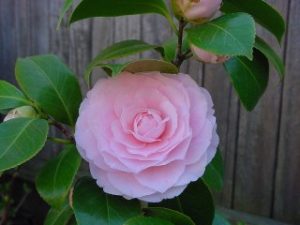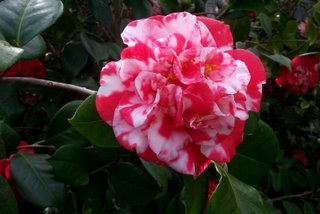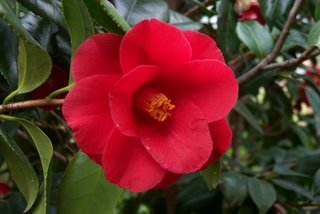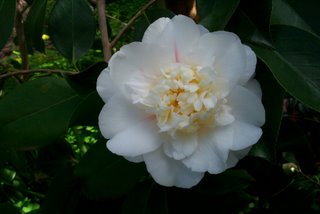
CAMELLIAS
The most commonly grown camellias in the colder climates are the sasanqua, japonica, reticulata and more recently the hybrid types. The major advantage of the sasanqua type is that it will tolerate a greater degree of sun than other camellias and is thus more versatile as a general garden plant. In addition they mainly flower in late autumn and early winter when colour can be scarce in the garden. Camellia flower forms are quite varied but the main types are single, semi-double, informal double (including roseform and paeoniform), formal double and anemone (or elegans) form. A wide range of colours is also available but the darker colours perform best as they have blooms that are less easily discoloured by frost or sunlight.
PLANTING
Camellias are sold in pots and theoretically may be planted into the garden at any time. For best results however, avoid planting during climatic extremes when the plants will be under undue stress, ie late spring and summer when plants will dry out excessively; or in the middle of winter when the ground may be frozen for long periods. As these plants are surface-rooting they should be planted at the same level in the garden as in their pots. Planting too deeply results in poor growth and possible death due to root rot. Always soak the plant thoroughly before removing it from the pot, tip it out and handle by the root ball rather than the stem. For best results hose off as much soil as possible from the root ball and unravel the outside roots before planting. Spread the roots over a firm base of soil in the bottom of the hole and backfill with soil. Water well before completing the backfill to the level at which the plant sat in its original pot. Camellias can be spaced at least 2 metres apart and should be at least l metre away from a house wall or a fence. For a hedge, they can be spaced 1 metre apart.
TRANSPLANTING
The best time to transplant is when the plant is not in active growth, especially from late autumn to late winter. As the bulk of roots will be as great as the bulk of the plant above ground, do not underestimate (i) the amount of root ball that should be taken, (ii) the need to consider pruning back the plant to reduce stress and (iii) the size of the new planting hole. The newly transplanted bush will need diligent watering and staking for several years to establish. If you know you will need to move a camellia, then make a trench around at least half of the plant about 50 cm deep and 15 cm wide, some distance from the trunk. Back fill this trench with good soil with plenty of humus content and keep well-watered. New roots should then commence growing before the remaining half of the root system needs to be cut. If you cannot avoid transplanting at the ‘wrong’ time of year, then consider defoliating the plant and protecting it with a temporary shadecloth shelter.
PRUNING
Prune after flowering. Camellias may grow to the size of a small tree but size may be checked with pruning immediately after flowering, and before spring growth commences. In practice, prune and thin to control size and shape to keep the camellia to the desired size. Dead wood, weak spindly growth, and crossing and low growing branches should be removed to let in light and air. Long unproductive wood may be cut back severely, and should result in vigorous new growth.



WATERING
The proper watering of camellias is important and they should not be allowed to dry out. Leaf burn, appearing on plants that experience direct sunlight, is a sign of inadequate watering. The soil should be kept moist but not waterlogged. Drought has been a recurring phenomenon for many years. Well-established camellias seem to be quite drought-hardy once established but, even so, need a good soaking at least weekly in hot, dry weather and at least monthly in dry winters.
FERTILISERS AND MULCHING
Camellias are not gross feeders and appreciate mulch more than the heavy use of fertilisers. If they are grown in soil with a reasonable percentage of humus they should grow and flower well. However, the general health of the plants and the size of the blooms may be improved by the application of fertilisers. Suitable fertilisers can be either organic, such as cow or sheep manure, or inorganic, such as ready mixed Camellia and Azalea foods or complete general purpose fertilisers. Fertilise only when the soil is moist, spreading it evenly under the bush but not against the main stem. Too much fertiliser could damage the plant and in extreme cases, cause death. Fertilise in early spring, and do a small follow-up in mid-summer. The application of humus around the bush is most beneficial. The humus material could be well-rotted compost, pine needles, leaf mould, cow or sheep manure. Spread at a depth of about 8cm around established bushes and 4cm around small plants. This mulching will assist in conservation of moisture and will keep the roots cool in summer.
PESTS AND DISEASES
Camellias are generally trouble-free. Young plants may suffer more than older ones from caterpillars. Aphids can distort young growth and scale is occasionally seen. In late spring, old camellia leaves are often shed — this is a normal occurrence. Viruses in camellias are generally benign but they can cause variable yellow spotting or mottling of the leaves and white spotting or mottling of the petals.
CAMELLIAS TO GROW
Choosing a camellia depends on personal taste. There is a very large range available. It is best to see the plant flowering before making a choice. The plant label should indicate when the plant will bloom, and in general, early to mid-season bloomers are better for Canberra. A comprehensive list is available in the Canberra Gardener.
Also see the Camellias Australia Inc. website at www.camelliasaustralia.com.au







